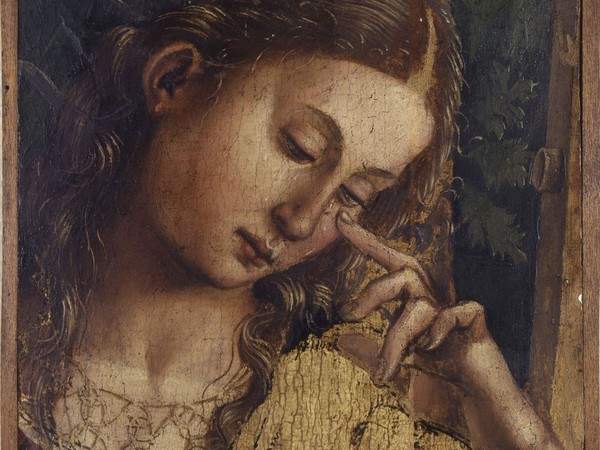Sacred and profane between the Middle Ages and the Modern Age: an exhibition for the refurbishment of the Palazzo d'Accursio in Bologna
The exhibition The Soul and the Body opens in Bologna. Images of the Sacred and the Profane between the Middle Ages and the Modern Age, which will run from November 9, 2018 to February 24, 2019.
The rearrangement of a part of the Collezioni Comunali d’Arte, which was necessary to allow work on the roofs of Palazzo d’Accursio, has been turned into an opportunity to juxtapose the museum’s works differently and make them dialogue in a thematic path. Through subjects dear to the figurative culture of past centuries, the change from the 13th to the 18th century in the use of the human figure in Western art to narrate both the essence of the divine and everyday life and feelings is recounted. In the exhibition, rooms devoted to the two aspects alternate, showcasing the rich collection of medieval sculptures and paintings, the precious panels by Francesco Francia, Amico Aspertini and Luca Signorelli, and canvases by Prospero Fontana, Ludovico Carracci, Guido Cagnacci, Donato Creti, Gaetano Gandolfi, and Pelagio Palagi.
The Middle Ages resorted to the representation of the body in order to give an identity to the religious dimension in its different manifestations(Eternal Father, Christ, the Virgin, the saints), while in the Renaissance the body represented in a naturalistic way became essential to give a face to holiness and facilitate the dissemination of Catholic doctrine. Frequently in the Middle Ages and the Renaissance, sacred images are accompanied by donors, devotees and wealthy individuals who financed the work in the hope that it would count as intercession for the afterlife. But religious sentiment was also cultivated in the domestic sphere, as shown by portable triptychs and small devotional tables. Over the centuries, the role of saints also changed: in the Middle Ages the martyrs of the origins of Christianity were venerated and thus represented above all; in the Renaissance and later ages new saints were preferred, placed in scenes in the presence of the deity (for example, in the Holy Family or at the foot of the Crucifix) or in concentrated prayers, which were meant to be a strong example for the practice of the faithful.
At the same time, narratives of the passions of men became established, which were often recognized in stories of ancient heroes or in allegories of vices and virtues. The sixteenth century in particular favors complex allegories and metaphors, both literary and visual, in which not infrequently a seemingly easily recognizable subject actually alludes to far more subtle themes. Therefore sometimes a mysterious feature or a curious emblem surrounds faces with a special aura, making portraiture a highly valued genre also because of the artists’ ability to depict the psychological intensity of the subject, his or her social condition.
Some themes touched the souls of the faithful more closely: all the episodes in the life of the Virgin and Christ, from theAnnunciation to the fulfillment of the Passion. While those story-defining elements are present, the different settings and iconographic variations convey to us the thought of an era. The theme of the Deposition, so popular in the 16th century, is well documented in this room, thanks in part to the extraordinary opportunity to partially reconstruct a lost masterpiece by Luca Signorelli, the Matelica altarpiece of 1504, by reuniting two fragments that belonged to it: the Weeping Woman’s Head, from the Collezioni Comunali d’Arte, and the Dead Christ, given to the museum on deposit by Banca UniCredit.
Seventeenth- and eighteenth-century portraits of aristocrats and wealthy bourgeois dialogues in Room 19 with the faces of men and women dear to Pelagio Palagi, who had depicted them posed, but often dwelling only on the study of the expression on their faces. The eclectic artist’s painting also brings the visitor’s attention back to mythological themes and the educational importance they had in late 18th- and 19th-century civilization as a vehicle for moral instruction. Gods and heroes of ancient Greece or the epic figures of Roman history (Room 20) were no longer the protagonists of prissy pictures to decorate drawing rooms and boudoirs, but emblematic figures whose deeds and courage were to serve as examples in a present populated by new ideals.
The exhibition concludes in the monumental Urban Hall, giving voice to both strands of the narrative: the visitor can choose whether to conclude by first admiring the works that speak most to the soul then those that primarily stimulate the senses, or vice versa. The soul is captivated by close observation of extraordinary carved and painted Crucifixes, which between the 13th and 15th centuries hung in churches and chapels to define the boundary between the space of the clergy and the space of the faithful. The senses are captivated by the perfect and barely disturbing forms of the half-naked deities-allusions to the knowledge and expertise of men-painted by Donato Creti, wrapped in fabrics and lights where the mellow, intense colors cautiously begin to tell the story of the upheaval of the modern age.
For more information you can visit www.museibologna.it/arteantica and museibologna.it/ or email museiarteantica@comune.bologna.it.
Pictured: Luca Signorelli, Saint Mary Magdalene Weeping (c. 1500-1510; oil on panel, 24.5 x 26.2 cm; Bologna, Collezioni Comunali d’Arte)
 |
| Sacred and profane between the Middle Ages and the Modern Age: an exhibition for the refurbishment of the Palazzo d'Accursio in Bologna |
Warning: the translation into English of the original Italian article was created using automatic tools. We undertake to review all articles, but we do not guarantee the total absence of inaccuracies in the translation due to the program. You can find the original by clicking on the ITA button. If you find any mistake,please contact us.





























